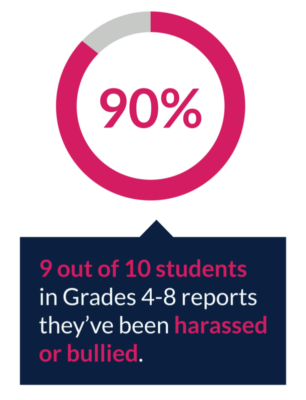While many school leaders know bullying is an issue that can lead to mental health problems and lower academic success, how do K-12 schools address bullying?
Bullying prevention and intervention begins with awareness. Knowing the warning signs of bullying is key to mitigating issues in your school district. Not all students who are involved in bullying will report it to a trusted adult, so school leaders need to know what to look out for.

It’s important to talk with students who show signs of being bullied or bullying others. These warning signs can also point to other serious issues, such as depression or substance abuse. Starting a conversation about the student’s concerning behavior can help get to the root cause.
While this is not an exhaustive list, these are some of the warning signs that indicate a student may be involved in bullying or cyberbullying. Have educators and school staff in your school district be on the lookout for these signs so they can help stop and prevent bullying and cyberbullying at your school.
Signs a student is physically being bullied or bullying others
Look for behavior changes in the child. However, be aware that not all children who are being bullied exhibit warning signs.
Some warning signs that suggest a child is being bullied are:
- Unexplainable injuries.
- Lost or destroyed clothing, books, electronics, or jewelry.
- Frequent headaches, stomach aches, feeling sick, or faking illness.
- Changes in eating habits, like suddenly skipping meals or binge eating. Kids may come home from school hungry because they did not eat lunch.
- Difficulty sleeping or frequent nightmares.
- Declining grades, loss of interest in schoolwork, or not wanting to go to school.
- Sudden loss of friends or avoidance of social situations, even those they enjoyed in the past.
- Feelings of helplessness or decreased self-esteem.
Kids may be bullying others if they:
- Get into physical or verbal fights.
- Have friends who bully others.
- Are increasingly aggressive.
- Frequently get sent to the principal’s office or detention.
- Have unexplained extra money or new belongings.
- Blame others for their problems.
- Don’t accept responsibility for their actions.
- Are competitive and worry about their reputation or popularity.
Keep in mind, while many of these warning signs can point to physical bullying, many of them also overlap with warning signs of cyberbullying. Additional warning signs of cyberbullying are below.
Warning signs a student is being cyberbullied or cyberbullying others
It’s important to pay attention to the devices and online platforms students use because many of the cyberbullying warning signs take place on these devices. The more devices and digital platforms students use, the more opportunities there are for them to be exposed to potential cyberbullying. Further, many social media websites allow users to remain anonymous, meaning, remaining vigilant is key to identifying cyberbullying.
These Cyberbullying warning signs include:
- A noticeable increase or decrease in device use, including texting.
- A student exhibits strong emotional responses (laughter, anger, distress, sadness, etc.) to what is happening on their device.
- A student hides their screen or device when others are near and avoids discussion about what they are doing on their device.
- Social media accounts are shut down or new ones appear.
K-12 schools should watch for the above cyberbullying warning signs and inform the parents and caregivers in their community to be mindful of these warning signs as well. In the event that some of these warning signs appear, school staff can intervene and begin a conversation with the student to address the cyberbullying.

Leverage technology for warning signs of bullying
The better-equipped teachers and staff are to identify and address warning signs of bullying, the less often they will find themselves discovering instances of bullying after the fact.
Fortunately, student safety monitoring tools like Lightspeed Alert™ can detect signs of bullying in real time, helping schools intervene before a situation escalates to violence or self-harm. By picking up on warning signs that would otherwise go undetected, these solutions and the safety experts behind them keep communities safer 24x7x365. To make sure your district has the tools it needs to address the bullying and cyberbullying issues students face, talk to a Lightspeed professional today.
To learn more about how to equip your team and K-12 community members with the knowledge and tools necessary to mitigate issues of bullying and cyberbullying, download our free guide Tactics to Stop Bullying and Cyberbullying in K-12 Schools.

